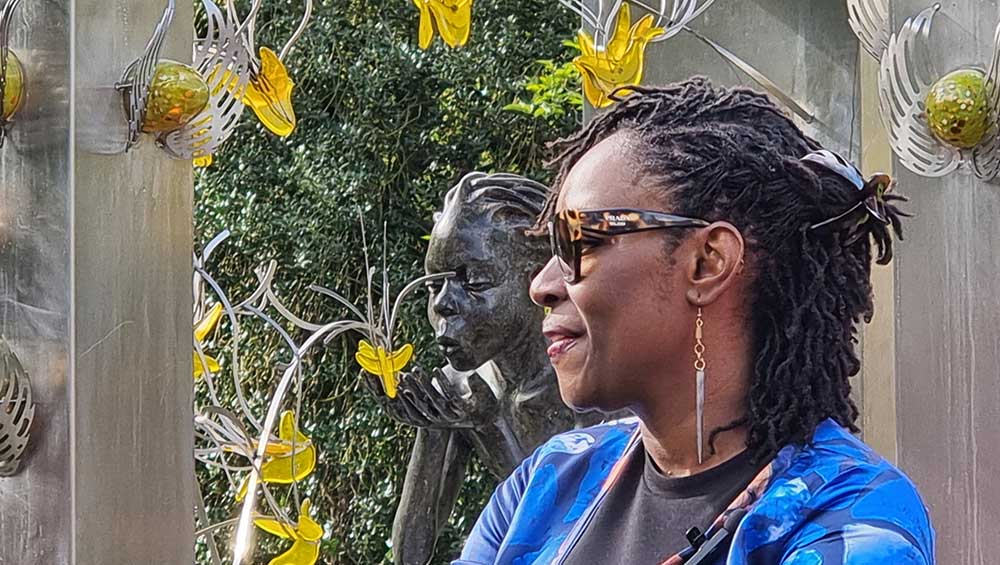
Péju Alatise with Sim and the Glass Birds at Frieze Sculpture, Regent’s Park, London, 2022. Photo: Juliet Rix.
by JULIET RIX
Born in Nigeria in 1975, Péju Alatise, is a multimedia artist focusing on the experience of women and girls, particularly in her native country but with resonance across the world. She is a fellow of the Smithsonian Institution’s National Museum of African Art (in Washington DC) and has represented Nigeria at the Venice Biennale. She was brought up in Lagos, but has recently moved to Scotland.
Alatise read architecture at Ladoke Akintola University in Oyo State, graduating in 1998, the year Nigeria’s military head of state, Sani Abacha, died and the country began to emerge from military dictatorship and consider its future. Starting off in the world of architecture and interior design, Alatise soon crossed fully into the fine arts, opening her own studio making sculpture and painting, mostly with local materials. She is also a writer, author of a number of stories and one full-length novel, Orita Meta: the Crossroads (2006).
Through her art and more broadly, Alatise has always been a strong advocate for the rights of women and girls in Nigeria, particularly with the Child Not Bride campaign to end child marriage. This was the subject of her sculpture Nine-Year-Old Bride (2013), made to coincide with a debate on the subject in the Nigerian parliament. She has been equally adamant in drawing attention to the plight of the 276 girls taken from their school by Boko Haram terrorists in 2014, which she addressed in Missing.
-(2).jpg)
Péju Alatise. Nation Interrupted, 2014. Photo © Péju Alatise.
Her disgust at the failure of government and civil society to address such matters successfully, and the way this impacts on ordinary people, led to Nation Interrupted (2014), in which a gaggle of damaged, grey, life-sized figures is trapped, and isolated from one another, by a maze of turnstiles, glassless windows and doorways.
.jpg)
Péju Alatise. Flying Girls, 2016. Fibreglass, metal, resin and black paint. Photo © Péju Alatise.
Despite her sometimes controversial outspokenness and anti-government stances, Alatise was chosen, along with two male artists, to represent Nigeria at the Venice Biennale in 2017 when the country had a pavilion for the first time. Her contribution was Flying Girls, a work that marked a shift in her practice from overtly dark and political to something more dreamlike, a style still very much in evidence in Sim and the Glass Birds, presented at Frieze Sculpture in Regent’s Park, London, in autumn 2022.
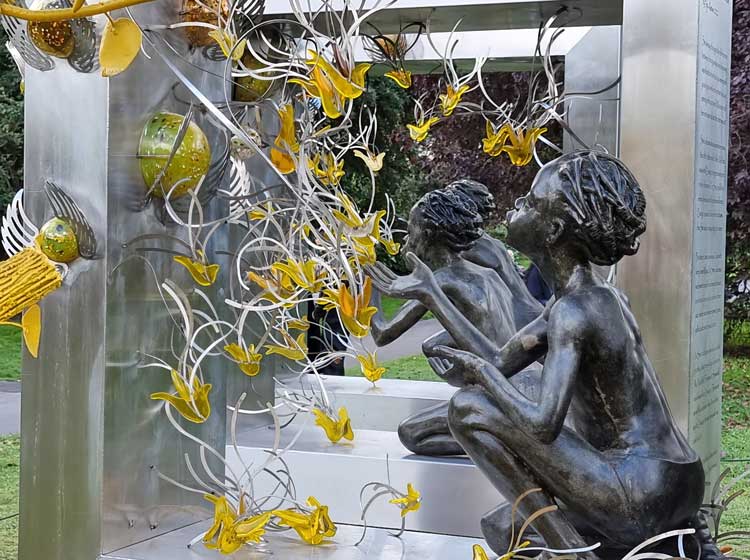
Péju Alatise. Sim and the Glass Birds at Frieze Sculpture, Regent’s Park, London, 2022. Photo: Juliet Rix.
Also in 2017, Alatise won the FNB prize at the Johannesburg Art Fair (the longest running and most prestigious fair in Africa for contemporary African artists) and launched her Alter Native Artists Initiative (ANAI) Foundation, creating a physical (as well as psychological) space in Lagos for artists to work together and break down barriers.
During the Covid pandemic, Alatise moved to the UK, opening a new studio in Glasgow, from where she spoke to Studio International about her work and convictions, past and future.
Juliet Rix: How would you describe yourself and your work?
Péju Alatise: I am a storyteller. In Nigeria, storytelling is part of day-to-day life. My grandmothers (I never knew my grandfathers) and extended family told stories – all of them, all the time. I grew up in a big family. I have seven siblings, with just one or two-year age gaps between us. I am a very middle child, with all the middle-child syndromes … You learn to disappear. Above all, it teaches independence because people tend to forget you are there.
Growing up, there were always lots of children and lots of stories – and lots of singing. Every folktale comes with a song. When I was young, even political events ended up being songs. That’s how you remembered what year someone was president, who got shot, or which political parties were running. The songs were meant to be children’s rhymes, but they were political.
JR: You didn’t start out as a fine artist did you, instead reading architecture at university?
PA: I always knew I wanted to practise art, but for typical Nigerian parents if you weren’t studying medicine, law or accounting, you weren’t quite educated. Architecture was just about acceptable.
I think the moment it really clicked that I wanted to be an artist was at an art gallery when I was 17 or 18, at university already, and I saw an artwork by a Nigerian artist called David Dale. It was just a simple charcoal drawing – the silhouette of a woman’s face with a head tie. I looked for him and found him in his studio. David Dale was a very kind, warm, open person and he allowed me to visit his studio whenever I wanted.
JR: Do you have any other particular artistic influences?
PA: Mama Nike – her real name is Nike Davies-Okundaye – has been very important for me. She’s a Nigerian textile artist now in her 70s. And I’m in love with the work of the contemporary Mexican sculptor Javier Marin. His work is awesome. And as a younger artist, I studied Rembrandt and his use of light in painting.
JR: When you left university, what did you do?
PA: I worked for a couple of my father’s friends, then got a job with Ajose Adeogun, who had some wild ideas of how to contribute to architecture in Nigeria. He made me study Finnish architect and designer Alvar Aalto and adapt his ideas to interior spaces in Nigeria.
After a couple of years, I left to set up my own studio, at first designing and making furniture from local materials that were readily available in the market. For me, the furniture was like making sculptures, which was sort of what Aalto did. I didn’t want to just make a chair; I wanted to make a chair that told a story. From furniture, I moved on to making anything and everything.
JR: Where was your first studio?
PA: In my father’s garage. He was always so upset with me. He thought I was wasting my life making nonsense.
JR: Did he ever come round to your work as an artist?
PA: Eventually, shortly before he passed. About a year before his Alzheimer’s completely deteriorated, we had a very sincere conversation. A film-maker, Sandra Obiago, had made a series of films about Nigerian artists and performers, including a documentary about me and my work. My dad was invited to the debut, which included a standup comedian, Julius Agwu. He talked about how in Nigeria there is zero support for artists and how the odds are all against us. After the event, my dad called me and apologised.
JR: The value of comedy!
PA: Yes. In lockdown, only “essential workers” were allowed out, but what kept us sane was the arts – music, movies. We forget that the arts are essential, too – essential to our humanity. The influence of what artists do is boundless.
JR: Is it particularly hard to be a female artist in Nigeria?
PA: Everywhere the story is changing, definitely in Nigeria. The artists who are changing the perception in the west of what art from the continent of Africa looks like are mostly women. Women are now at the forefront. That gender disparity is an old story. A lot of curators are women now too. When I went to the Smithsonian in 2016 for a fellowship, most of the curators at the Museum of African Art were women.
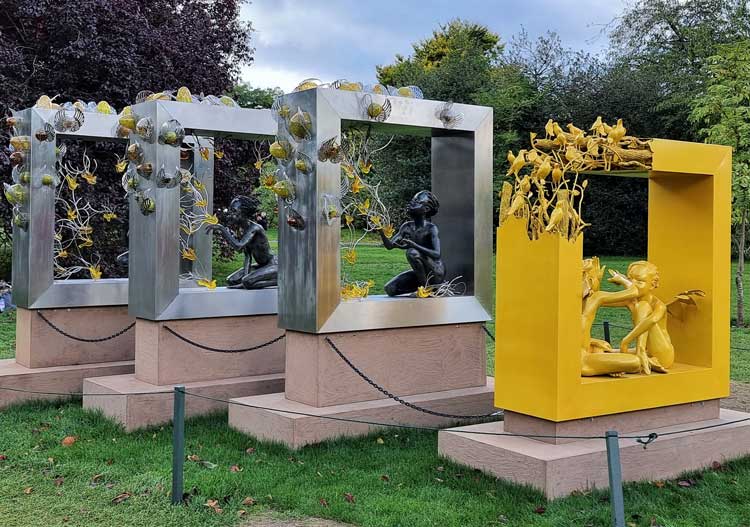
Péju Alatise. Sim and the Glass Birds at Frieze Sculpture, Regent’s Park, London, 2022. Photo: Juliet Rix.
When I did the Frieze in London (2022), the selection of artists [the curator] Clare Lilley had was wonderful: women, men, different races – a really well-balanced selection. Everyone is conscious of that diversity now. Things are changing. Fifty years ago in Nigeria women couldn’t even practise certain kinds of art. It’s much better now.
JR: You work in many and mixed media. How do you choose which media and materials to use for each work?
PA: Sometimes the story comes first – from my dreams or from my childhood; sometimes the material brings the story. In Nigeria, only certain materials were available, and in my architectural training we had to study the properties of materials. If you listen to materials, they tell you what they want to become. If you don’t listen, they can rebel against you. You have to understand them to get what you want.
JR: You also write and use words in your work.
PA: I have always written. People have called me a poet, but I would never describe myself as a poet. I’m a storyteller. Trying to write and make art separately was causing a fracture in my practice so I had to pull them together. They are just different ways of telling the same story.
JR: Most of your art focuses on the experience of women and girls.
PA: Yes. I am telling my own story from my perspective and experiences and what I see happening around me.
JR: Some of your work is quite dark, quite political – especially less recent work – about violence against women and women being very constrained?
PA: Yes. Back in Nigeria, that is everyday life. I’m lucky. Privileged. From a middle-class family with educated parents. When I look at those who are not so privileged, life is just not fair, egregiously so. I want to shed light, to have that conversation and sometimes you are shot down if you have that conversation. But you want to be heard. There was a time when my work was really dark, really angry, very political, very anti-government.
JR: When you spoke at Frieze a few months ago, you described your relationship with Nigeria as “like a battered wife”?
PA: Sometimes I feel abused by the country [she laughs]. It is exactly like a battered wife. Leaving Nigeria was a really difficult decision and I can’t say that I’ve really left the country. Leaving something you love so much and for which you have such great hopes and dreams of the future – it’s exactly like a relationship. You go into a marriage thinking that it’s for ever and have dreams about what the future will be like – and it doesn’t always work out. Far from it.
JR: Is Glasgow an easier partner?
PA: It has different challenges. It’s a new relationship so I can’t say, but I don’t feel battered.
JR: Why Glasgow?
PA: I wanted to expand my studio and I wanted somewhere between my practice in Lagos and the international market and it made sense to come to the UK. Choosing a place in the UK was a tough decision. I was invited to participate in the Glasgow International [festival of contemporary visual art] in 2020. It was cancelled because of Covid, but not having been there, I researched Glasgow and found out that it was a really beautiful, artist-friendly city.
I found an amazing space that I wouldn’t have been able to get elsewhere. It’s an old powerhouse that used to generate electricity for a shipyard where ships were built for the first and second world wars. I converted it into a studio. It was called the Old Power House, but we dropped the “Old” so it’s just the Power House.
JR: Do you intend to make Glasgow your primary home?
PA: I don’t know yet. The people are very friendly and kind. My studio is on an industrial complex. There are artists scattered around. I’ve met some of them and they’ve been very welcoming. I have a child who has just turned four who is in school here now and I think he might like this as his home.
I’m still in a weird space since Covid, trying to find a balance. Last year, I only went back to Lagos for Christmas. This year, I will go more often but for short visits. I still have a studio in Lagos and two artists in residence there. I’d like to keep the place running.
This year I will be opening my Glasgow studio to visitors, hopefully from June, and launching artists’ residencies there, probably for a couple of artists at a time, particularly those who want to make sculpture in materials the studio can provide –- metal, ceramics, wood. I am working on an online presence for the Power House.
.jpg)
Péju Alatise. Flying Girls, 2016 (detail). Fibreglass, metal, resin and black paint. Photo © Péju Alatise.
JR: In the last few years, your work has become much less overtly dark, more beautiful. What prompted that? It seems to have started around the time your father died?
PA: I wasn’t aware that my work was shifting. A friend pointed it out to me. When my dad passed away, I was making Flying Girls and I found myself always trying to find him in every work. I would have an orange butterfly and I’d tell people, that’s my dad.
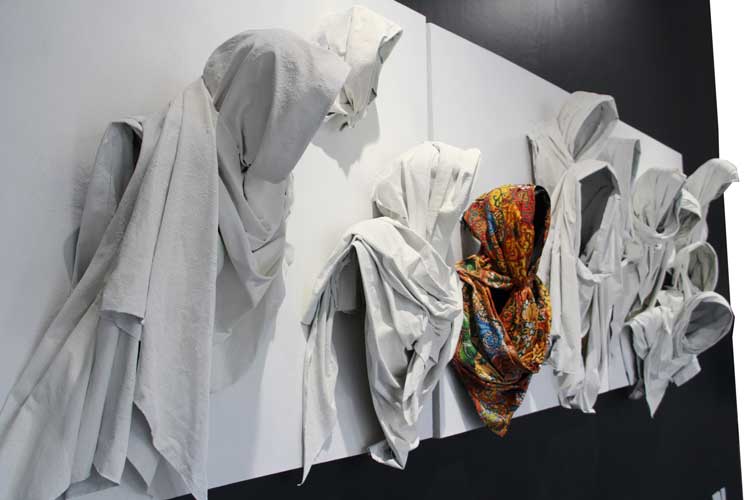
Péju Alatise. Orange Scarf goes to Heaven, 2012 (triptych). Nigerian cloth fixed and draped in a resin and mounted on canvas and acrylic. Photo © Péju Alatise.
JR: Why an orange butterfly?
PA: Ahh, the colour orange! This was a thing between me and my dad. He was a very dutiful Muslim; sometimes I felt he was borderline fanatical. One day we went to the mosque and the ushers wouldn’t let me in because I was wearing an orange scarf and they said it was too bright and distracting. I thought, what kind of god, with earthquakes and famine and everything, is bothered by a teenager’s orange scarf? That was the start of a series of orange scarves, and orange came to represent my rebellion against my dad and religion.
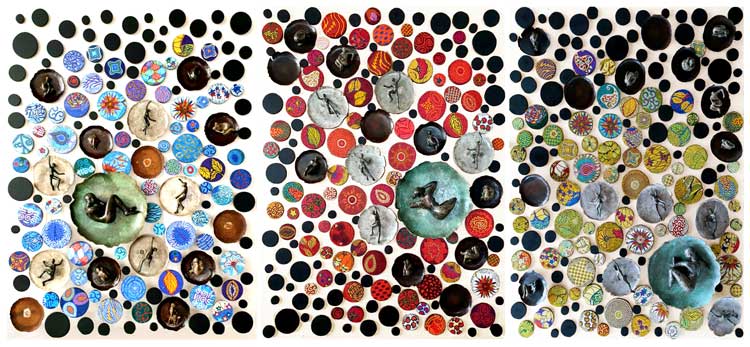
Péju Alatise. In the Beginning: Eve Should Have Stayed in Bed that Day, 2019. Wood, metal and granite stone cast plates mounted on 10mm Plexiglas, 201 x 150 x 18 cm (79 1/8 x 59 1/8 x 7 1/8 in). Photo © Péju Alatise.
I have a huge problem with religion in Nigeria – Islam and Christianity – because of the way it has deformed the minds of the people, stopped them thinking for themselves. My work Wrapture was partly about that – being a devil’s advocate to religion – and a few years ago I made a work called In the Beginning: Eve Should Have Stayed in Bed that Day (2019). That day at the mosque was the start of a whole series of orange scarves.
JR: Did having a child also contribute to changing your art?
PA: Probably, I’m not sure. It may just be that my son arrived as I was changing. But my work is a lot more whimsical now.
JR: There is perhaps more sense of hope?
PA: I think that is it, there is more hope. Rather than express the suffering of a child, I express the escapism, the dreams, of that child. I used not to like children at my shows, all running about and wanting to touch everything, but in 2013 a school brought some eight-, nine- and 10-year-olds to my show of Nation Interrupted – one of my dark shows – and I preferred their reaction to the adults’ reaction. There was more sensitivity and more honesty. I promised to create work for them. That, along with a visit to a friend who had a nine-year-old “house girl” (servant) led to Flying Girls. Now I prefer adults to appreciate my work more as a child would.
JR: Almost coming full circle to those political songs of your childhood that masqueraded as children’s rhymes, wrapping your message in a more acceptable exterior while the message inside is as tough as ever?
PA: Yes. There are messages people do not want to hear in Nigeria and I was told my delivery of the messages was wrong and I needed to make my work less angry, more approachable, then people would see the layers of the message underneath. So I use the stories and songs of my childhood – and make up my own – and the adults come down to the level of children to get the message.